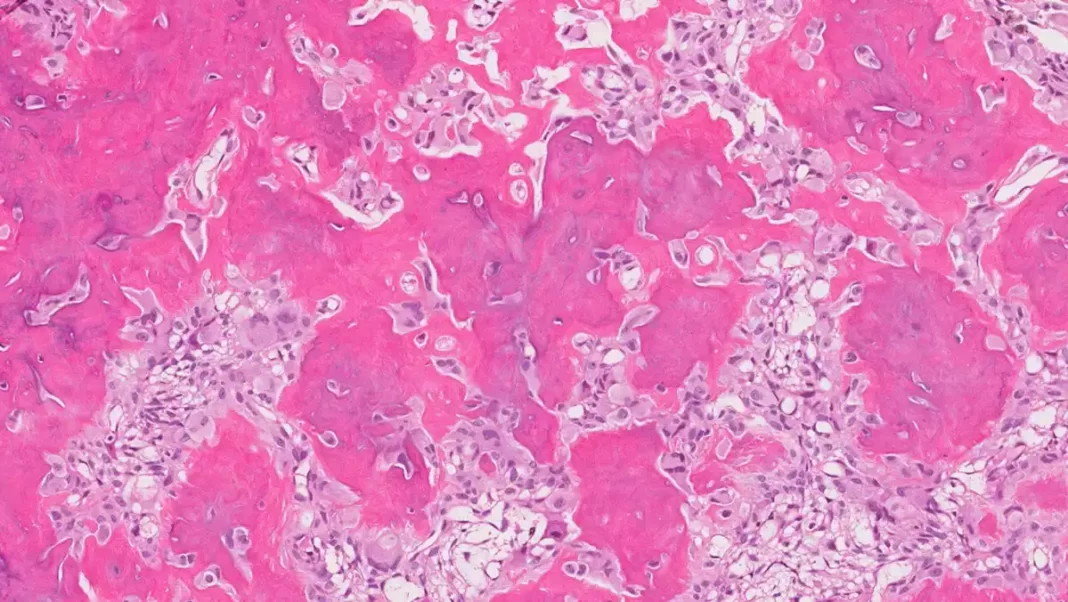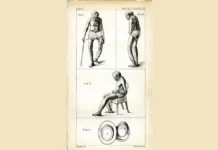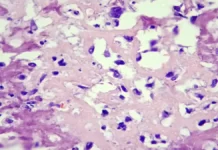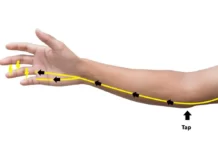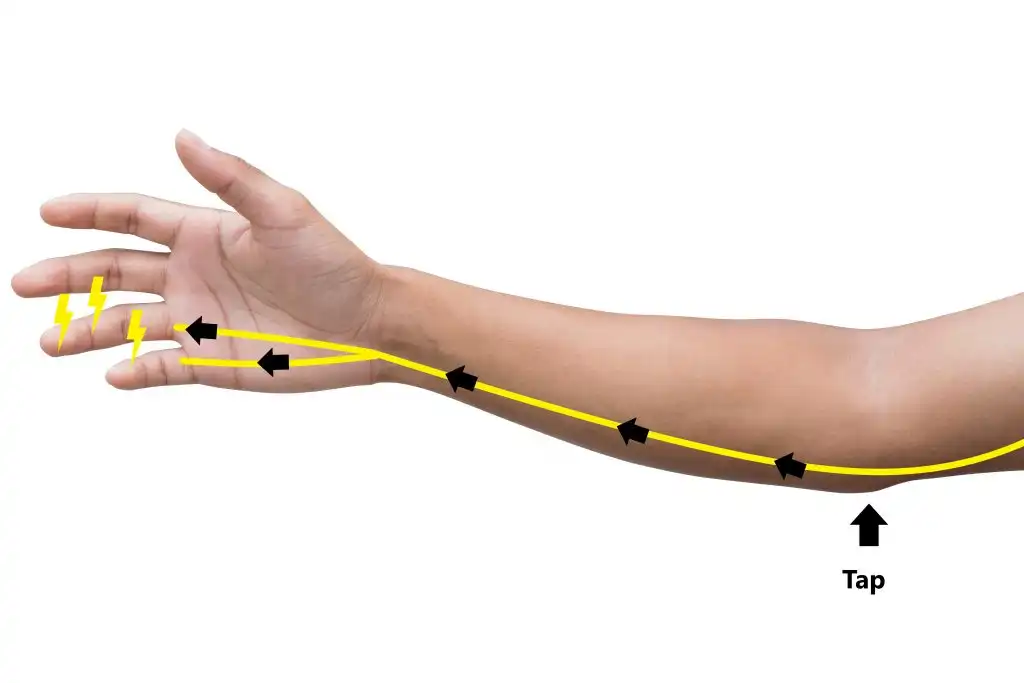Introduction
Osteoid osteoma is a relatively rare but distinctive benign bone tumor, developing most frequently in young adults and adolescents. As an osteopath, a thorough understanding of this condition is crucial for early recognition, accurate assessment and implementation of appropriate management strategies.
This tumor is characterized by a small lesion, often less than 2 centimeters, which develops within the bone tissue. Despite its benign nature, osteoid osteoma can cause severe bone pain, often at night, which can significantly affect the patient’s quality of life. The pain is generally described as intense and often responds favorably to the use of non-steroidal anti-inflammatory drugs (NSAIDs), which can be used to guide the diagnosis.
Anatomically, osteoid osteoma is often located in the long bones, particularly the femur and tibia, although it can also affect other bones in the body. The lesion consists of a small central area called the nidus, surrounded by a peripheral bony reaction. Medical imaging, such as computed tomography (CT) or magnetic resonance imaging (MRI), is often used to precisely locate the nidus and assess its extent.
Diagnostically, osteoid osteoma can sometimes be challenging due to its small size and similarity of symptoms to other conditions. However, the response to NSAIDs, in addition to specific radiographic and CT features, helps confirm the diagnosis. As an osteopath, working collaboratively with radiologists and other healthcare professionals is essential to ensure a thorough diagnostic assessment.
Management of osteoid osteoma varies depending on the location of the tumor and the intensity of the symptoms. In many cases, a conservative approach is taken, using NSAIDs for pain relief. However, when pain persists despite drug treatment or when the tumor causes complications, more invasive interventions may be considered.
The surgical approach, often performed by an orthopedist, aims to excise the nidus while preserving as much of the surrounding bone tissue as possible. Advances in surgical techniques, such as radiofrequency-assisted surgery, have allowed for less invasive procedures and faster recovery.
Pathology of osteoid osteoma
Osteoid osteoma is a bone pathology characterized by the presence of a small benign tumor, called nidus, within the bone tissue. This condition, although not cancerous, can cause painful symptoms and requires a careful approach to diagnosis and management.
The main characteristic of osteoid osteoma is the severe bone pain it can cause. Patients frequently report nighttime pain, described as deep and stabbing, often exacerbated by rest. This pain is often a trigger for medical consultation, and the specificity of the response to taking non-steroidal anti-inflammatory drugs (NSAIDs) can guide the diagnosis.
Anatomically, osteoid osteoma usually develops in the long bones of the body, such as the femur or tibia. However, it can also affect other parts of the skeleton. The lesion itself, the nidus, is a small central area surrounded by a peripheral bony reaction. This characteristic pattern is often identified through medical imaging tests such as computed tomography (CT) or magnetic resonance imaging (MRI).
Diagnosing osteoid osteoma can sometimes be a challenge due to its small size and the similarity of its symptoms to other conditions. However, favorable response to NSAIDs, combined with specific radiographic and CT features, helps confirm the diagnosis. Close collaboration with radiologists and other healthcare specialists helps ensure a thorough diagnostic evaluation.
In terms of management, different approaches can be considered depending on the severity of the symptoms. In many cases, a conservative approach is favored, using NSAIDs for pain relief. However, when pain persists or when the tumor causes complications such as pathological fractures, more invasive interventions may be necessary.
Surgery represents an option for the treatment of osteoid osteoma. The goal is usually to excise the nidus while preserving as much surrounding bone tissue as possible. Advances in surgical techniques, such as radiofrequency-assisted surgery, allow for less invasive procedures, reducing post-operative recovery time.

The nidus releases prostaglandins (via the enzymes cyclo-oxygenase-1 and cyclo-oxygenase-2) which in turn cause pain 2 .

Causes of osteoid osteoma
The exact cause of osteoid osteoma is not fully understood, but is thought to be related to genetic factors and abnormalities in bone development. Here are some things related to the causes of osteoid osteoma:
- Genetic Factors: Genetic predispositions may play a role in the development of osteoid osteoma. Some families may have an increased susceptibility to this condition, suggesting a genetic component.
- Abnormalities in Bone Differentiation: Osteoid osteoma is characterized by the presence of a nidus, which is a small tumor composed of immature bone tissue. Abnormalities in normal bone cell differentiation may contribute to the formation of this abnormal structure.
- Hormonal Factors: Some experts suggest that variations in hormonal levels, particularly during pubertal growth, could influence the development of osteoid osteoma. However, the exact relationship between hormones and this condition still requires extensive research.
- Local Inflammatory Response: It has been proposed that osteoid osteoma may result from a local inflammatory response to unfamiliar stimuli. This could lead to the formation of a nidus and associated symptoms.
- Trauma or Microtrauma: Some cases of osteoid osteoma have been associated with a history of trauma, but the exact link between trauma and the development of this condition is not completely understood. Some experts believe repetitive strain injuries may be involved.
- Vascular Factors: Vascular abnormalities within the bone have also been suggested as a contributing factor in the formation of osteoid osteoma.
Symptoms of osteoid osteoma
- Pain: Pain is the dominant symptom of osteoid osteoma. The pain is usually intense, localized and described as throbbing or throbbing. It tends to be more intense at night and can often be relieved by taking nonsteroidal anti-inflammatory drugs (NSAIDs).
- Increased pain with activity: Osteoid osteoma pain tends to get worse during physical activity or movement of the affected area.
- Rapid Response to NSAIDs: Pain associated with osteoid osteoma usually responds quickly to taking NSAIDs, which may help differentiate this condition from other conditions.
- Joint Stiffness: Some patients may experience joint stiffness in the area affected by the osteoid osteoma.
- Localized swelling: Mild swelling may sometimes be present in the area surrounding the osteoid osteoma.
Pathophysiology of osteoid osteoma
The pathophysiology of osteoid osteoma involves changes in bone tissue, leading to the formation of a small tumor called a nidus. Although the precise mechanisms are not fully understood, some features of osteoid osteoma pathophysiology include:
- Formation of the Nidus: The central element of the osteoid osteoma is the nidus, a small area of abnormal bone tissue. This nidus is made up of immature bone cells (osteoids) and abnormal blood vessels.
- Local Inflammation: Some cases of osteoid osteoma are accompanied by local inflammation. It is thought that inflammatory factors may be involved in nidus formation and contribute to symptoms such as pain.
- Peripheral Bone Reaction: Around the nidus, a peripheral bone reaction occurs. This manifests itself as increased bone density (sclerosis) in the surrounding area. Peripheral sclerosis can be seen on imaging tests such as x-rays.
- Abnormal Vascularization: Osteoid osteoma is associated with abnormal vascularity, with blood vessels that may be dilated and irregular. This atypical vascularity may contribute to pain and other symptoms.
- Release of Pro-Inflammatory Substances: Some cases of osteoid osteoma have a local release of pro-inflammatory substances, which may contribute to pain and inflammation.
- Response to Hormonal Growth: Osteoid osteoma tends to develop during pubertal growth, suggesting a possible response to hormonal changes associated with this period.
Treatment of osteoid osteoma
Treatment for osteoid osteoma usually involves surgical removal of the nidus, the small tumor causing the symptoms. Here are some aspects of treating osteoid osteoma:
- Excision Surgery: The surgical procedure involves surgically removing the nidus. This procedure is usually performed by an orthopedist or specialized orthopedic surgeon. The goal is to completely remove the tumor while preserving as much of the surrounding bone structure as possible.
- Preoperative Imaging: Before surgery, imaging tests such as computed tomography (CT) or magnetic resonance imaging (MRI) can be used to precisely locate the nidus and plan the procedure.
- Percutaneous Guidance: In certain cases, particularly when the nidus is difficult to access or located in a delicate area, percutaneous guidance techniques can be used. This may involve using computer-guided CT scanning to direct a needle to the nidus for ablation.
- Rapid Relief of Symptoms: Removal of the nidus usually results in rapid relief of symptoms, especially pain. Patients often experience significant improvement shortly after surgery.
- Postoperative Follow-up: After surgery, postoperative follow-up is usually performed to monitor healing and ensure there are no complications. Imaging tests may also be performed to confirm complete removal of the nidus.
- Avoidance of Activity: In the first weeks following surgery, avoidance of intense physical activity may be recommended to allow optimal healing.
- Nonsteroidal Anti-Inflammatory Drugs (NSAIDs): NSAIDs may be prescribed to relieve postoperative inflammation and pain.
A Day in the Life of Someone Suffering from Osteoid Osteoma
6:00 AM: The Painful Awakening
As the morning light creeps through the curtains, Sarah, a 28-year-old university student, is already awake. She often experiences disrupted sleep due to the deep, aching pain caused by her osteoid osteoma. This benign bone tumor, most commonly affecting young adults, has been residing in her femur for over a year now, turning her nights into a battleground against relentless discomfort. The pain seems to intensify at night, a characteristic feature of this condition, and she’s spent yet another restless night tossing and turning.
7:00 AM: Morning Routine with Challenges
Sarah gingerly rolls out of bed, careful not to put too much pressure on her affected leg. Her morning routine is punctuated by the necessary intake of pain medication. Nonsteroidal anti-inflammatory drugs (NSAIDs) have become her constant companion, providing some relief, but never quite enough. The dull ache in her leg makes even simple tasks like brushing her teeth and dressing a careful balancing act. She often wonders if today will be a better day or another struggle against the persistent throbbing in her leg.
9:00 AM: Navigating Campus Life
Getting to campus is a challenge that requires meticulous planning. The walk from her apartment to the university used to be an enjoyable part of her day, but now it’s a slow, cautious journey. Sarah has had to adjust her pace and allow extra time to manage the pain that flares up with prolonged walking or standing. Her friends are supportive, offering to carry her bag or walk alongside her, but she often feels the weight of her condition both physically and emotionally.
11:00 AM: Concentration Battle in Class
In class, Sarah finds herself struggling to concentrate. The osteoid osteoma not only affects her physical well-being but also takes a toll on her mental state. The constant pain is a distraction that makes focusing on lectures and taking notes more difficult than ever before. Despite the challenges, Sarah is determined to not let her condition define her academic success. She takes meticulous notes, relying on voice recordings when writing becomes too painful, and keeps a positive attitude.
1:00 PM: Seeking Relief at the Osteopath
During lunch, Sarah visits her osteopath for a regular session. Osteopathy offers her a complementary approach to managing her pain. Her osteopath works on alleviating some of the discomfort through gentle manipulation and advice on posture and movement strategies. These sessions offer a respite from the constant ache and provide her with tools to manage her daily activities more effectively. The osteopath’s holistic approach complements her medical treatments, focusing on improving her quality of life despite her condition.
3:00 PM: A Struggle with Afternoon Fatigue
By mid-afternoon, fatigue sets in. The combination of pain and disrupted sleep leaves Sarah feeling exhausted. Her energy levels dip, making it difficult to stay engaged with her studies and socialize with friends. She often retreats to a quiet corner of the library to rest and catch up on reading. The osteoid osteoma has made her more aware of her limitations, teaching her the importance of listening to her body and taking breaks when needed.
6:00 PM: Evening Exercise Routine
Sarah is committed to maintaining her physical health, even though exercise requires modifications. She heads to the gym for a low-impact workout, focusing on exercises that strengthen her muscles without aggravating her condition. The gym staff is aware of her limitations and helps design a routine that accommodates her needs. Exercise, though sometimes painful, offers her a sense of control and accomplishment. It’s a reminder that she can still pursue activities she loves with some adjustments.
8:00 PM: Quiet Evenings and Reflection
As the day winds down, Sarah finds solace in quiet evenings at home. She practices mindfulness meditation to manage the stress and anxiety that accompany her condition. This time for reflection helps her maintain a positive outlook despite the challenges. Sarah is hopeful about the future, knowing that surgical intervention may eventually be an option to remove the tumor and alleviate her symptoms.
10:00 PM: Preparing for Another Night
As she prepares for bed, Sarah is hopeful for a night of restful sleep. She’s learned to navigate life with osteoid osteoma, balancing the demands of daily life with the realities of living with chronic pain. Each day is a testament to her resilience and determination to live life on her terms. While the journey is challenging, Sarah remains optimistic, knowing that she is not defined by her condition but by her strength in overcoming it.
4o
Radiographic sign of osteoid osteoma
The radiographic signs of osteoid osteoma can vary, but some characteristic features can be seen in radiographic images (x-rays) of the affected area. Here are some potential radiographic signs of osteoid osteoma:
- Nidus: The most characteristic radiographic sign of osteoid osteoma is the presence of a nidus, a small area of abnormal bone that makes up the tumor itself. The nidus usually appears as a clear (radiolucent) region within the bone, surrounded by bony reaction.
- Peripheral sclerosis: Around the nidus, peripheral sclerosis, an increase in bone density, is often observed. This sclerosis may be visible as a dense line surrounding the affected area.
- Bone reaction: Osteoid osteoma usually causes a local bone reaction, characterized by an increase in bone density and changes in the surrounding bone structure.
- Periosteal swelling: In some cases, periosteal swelling (formation of new bone layer on the surface of the bone) may be visible on x-rays.
- Central clear zone: The nidus itself may appear as a central clear zone, surrounded by a denser zone.
It is important to note that osteoid osteoma can sometimes be difficult to visualize on standard radiographs, particularly when located in complex areas or surrounded by important anatomical structures. In such cases, more advanced imaging techniques, such as computed tomography (CT) or magnetic resonance imaging (MRI), can be used for more detailed visualization of the nidus and its characteristics.
References
- Visceral Pleural Invasion in Pulmonary Adenocarcinoma: Differences in CT Patterns between Solid and Subsolid Cancers Benedikt H. Heidinger et al., Radiology: Cardiothoracic Imaging, 2019
- Automated Analysis of Alignment in Long-Leg Radiographs Using a Fully Automated Support System Based on Artificial Intelligence Justus Schock et al., Radiology: Artificial Intelligence, 2020
- Automatic Detection of Inadequate Pediatric Lateral Neck Radiographs of the Airway and Soft Tissues using Deep Learning Elanchezhian Somasundaram et al., Radiology: Artificial Intelligence, 2020
- Automated Assessment and Tracking of COVID-19 Pulmonary Disease Severity on Chest Radiographs using Convolutional Siamese Neural Networksn Matthew D. Li et al., Radiology: Artificial Intelligence, 2020
- Florida Drops Quest for SARS-CoV-2 Testing Due to Reporting Delay staff reporter, 360Dx, 2020
- Management of Incidental Breast Lesions Detected at Nuclear Medicine Examinations W. Tania Rahman et al., Radiology: Imaging Cancer, 2020

